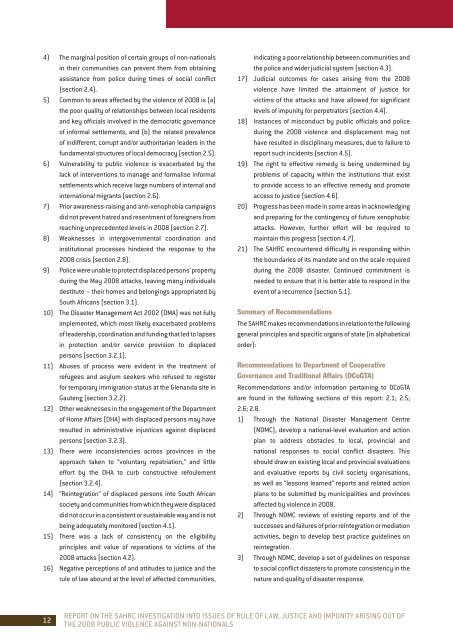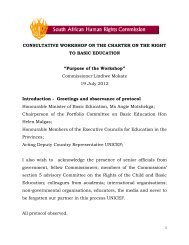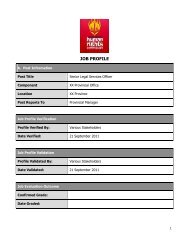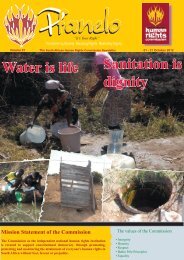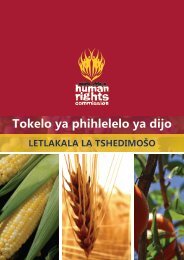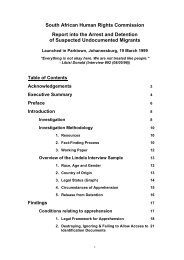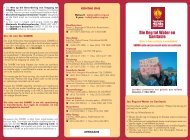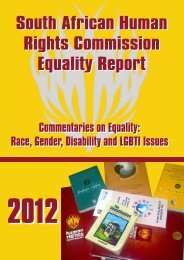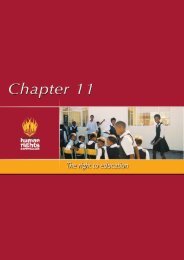Chapter 1 - South African Human Rights Commission
Chapter 1 - South African Human Rights Commission
Chapter 1 - South African Human Rights Commission
Create successful ePaper yourself
Turn your PDF publications into a flip-book with our unique Google optimized e-Paper software.
4) The marginal position of certain groups of non-nationals<br />
in their communities can prevent them from obtaining<br />
assistance from police during times of social conflict<br />
(section 2.4).<br />
5) Common to areas affected by the violence of 2008 is (a)<br />
the poor quality of relationships between local residents<br />
and key officials involved in the democratic governance<br />
of informal settlements, and (b) the related prevalence<br />
of indifferent, corrupt and/or authoritarian leaders in the<br />
fundamental structures of local democracy (section 2.5).<br />
6) Vulnerability to public violence is exacerbated by the<br />
lack of interventions to manage and formalise informal<br />
settlements which receive large numbers of internal and<br />
international migrants (section 2.6).<br />
7) Prior awareness-raising and anti-xenophobia campaigns<br />
did not prevent hatred and resentment of foreigners from<br />
reaching unprecedented levels in 2008 (section 2.7).<br />
8) Weaknesses in intergovernmental coordination and<br />
institutional processes hindered the response to the<br />
2008 crisis (section 2.8).<br />
9) Police were unable to protect displaced persons’ property<br />
during the May 2008 attacks, leaving many individuals<br />
destitute – their homes and belongings appropriated by<br />
<strong>South</strong> <strong>African</strong>s (section 3.1).<br />
10) The Disaster Management Act 2002 (DMA) was not fully<br />
implemented, which most likely exacerbated problems<br />
of leadership, coordination and funding that led to lapses<br />
in protection and/or service provision to displaced<br />
persons (section 3.2.1).<br />
11) Abuses of process were evident in the treatment of<br />
refugees and asylum seekers who refused to register<br />
for temporary immigration status at the Glenanda site in<br />
Gauteng (section 3.2.2).<br />
12) Other weaknesses in the engagement of the Department<br />
of Home Affairs (DHA) with displaced persons may have<br />
resulted in administrative injustices against displaced<br />
persons (section 3.2.3).<br />
13) There were inconsistencies across provinces in the<br />
approach taken to “voluntary repatriation,” and little<br />
effort by the DHA to curb constructive refoulement<br />
(section 3.2.4).<br />
14) “Reintegration” of displaced persons into <strong>South</strong> <strong>African</strong><br />
society and communities from which they were displaced<br />
did not occur in a consistent or sustainable way and is not<br />
being adequately monitored (section 4.1).<br />
15) There was a lack of consistency on the eligibility<br />
principles and value of reparations to victims of the<br />
2008 attacks (section 4.2).<br />
16) Negative perceptions of and attitudes to justice and the<br />
rule of law abound at the level of affected communities,<br />
indicating a poor relationship between communities and<br />
the police and wider judicial system (section 4.3).<br />
17) Judicial outcomes for cases arising from the 2008<br />
violence have limited the attainment of justice for<br />
victims of the attacks and have allowed for significant<br />
levels of impunity for perpetrators (section 4.4).<br />
18) Instances of misconduct by public officials and police<br />
during the 2008 violence and displacement may not<br />
have resulted in disciplinary measures, due to failure to<br />
report such incidents (section 4.5).<br />
19) The right to effective remedy is being undermined by<br />
problems of capacity within the institutions that exist<br />
to provide access to an effective remedy and promote<br />
access to justice (section 4.6).<br />
20) Progress has been made in some areas in acknowledging<br />
and preparing for the contingency of future xenophobic<br />
attacks. However, further effort will be required to<br />
maintain this progress (section 4.7).<br />
21) The SAHRC encountered difficulty in responding within<br />
the boundaries of its mandate and on the scale required<br />
during the 2008 disaster. Continued commitment is<br />
needed to ensure that it is better able to respond in the<br />
event of a recurrence (section 5.1).<br />
Summary of Recommendations<br />
The SAHRC makes recommendations in relation to the following<br />
general principles and specific organs of state (in alphabetical<br />
order):<br />
Recommendations to Department of Cooperative<br />
Governance and Traditional Affairs (DCoGTA)<br />
Recommendations and/or information pertaining to DCoGTA<br />
are found in the following sections of this report: 2.1; 2.5;<br />
2.6; 2.8.<br />
1) Through the National Disaster Management Centre<br />
(NDMC), develop a national-level evaluation and action<br />
plan to address obstacles to local, provincial and<br />
national responses to social conflict disasters. This<br />
should draw on existing local and provincial evaluations<br />
and evaluative reports by civil society organisations,<br />
as well as “lessons learned” reports and related action<br />
plans to be submitted by municipalities and provinces<br />
affected by violence in 2008.<br />
2) Through NDMC reviews of existing reports and of the<br />
successes and failures of prior reintegration or mediation<br />
activities, begin to develop best practice guidelines on<br />
reintegration.<br />
3) Through NDMC, develop a set of guidelines on response<br />
to social conflict disasters to promote consistency in the<br />
nature and quality of disaster response.<br />
12<br />
REPORT ON THE SAHRC INVESTIGATION INTO ISSUES OF RULE OF LAW, JUSTICE AND IMPUNITY ARISING OUT OF<br />
THE 2008 PUBLIC VIOLENCE AGAINST NON-NATIONALS


